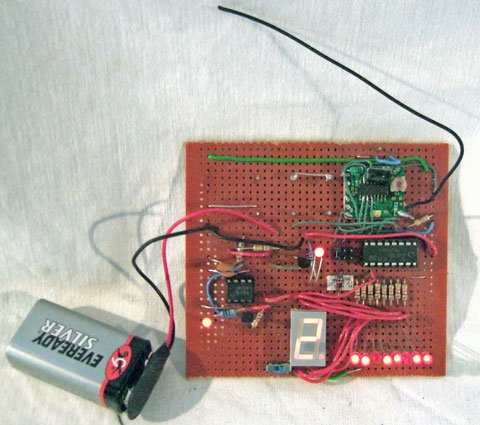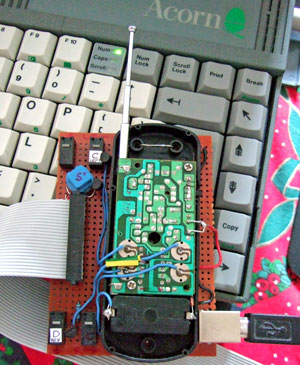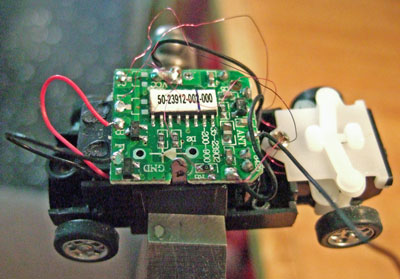| |  |
| Adapting a £6 R/C model car's circuit board to produce a low-speed 8-bit wireless I/O port for RISC OS |
 |
My preferred donor car for this conversion is the Shen Qi Wei 'Coke can' car range (on the left), introduced in 2010. Models from earlier years are also useable but the Coke car transmitter's clean shape and small size make the neatest adaptation.
The project is still at the crude proof-of-concept stage, as you can see below, but is already working as expected and showing reliable, low-speed (2Hz) parallel output at a range of 30-40 feet. Note that the USB connection is just there to provide a temporary 5v power source.
The row of LEDs on the receiver board (below left) show the state of the eight synthesized output lines. Those lines are also taken to the adjacent seven-segment display to create a more useful tell-tale view of the last byte decoded.
|
The low transmission speed is unfortuntely a function of the TX/RX chips' serial coding algorithm, plus the fact that the send/receive cycle has to be repeated nine times to transmit every byte (8 data bits + 1 latch bit). However, another hack I've seen suggests speed might be boosted to (swoon) 8Hz later.
Although the range is currently quite modest, I see electric airplane modellers have previously hacked the transmitter board with revised components, higher transmitter voltage and larger aerials - increasing the range to around 300 feet.
|
 |
 |
| The temporary USB connection supplies cheap 5v power for the transmitter. |
On the right is a typical receiver circuit board, as found in a Rastar branded Mini Cooper. The circuit board is tiny - see the protoboard's top right corner. Almost all the components are surface mounted, so a headband magnifier and fine pointed soldering tip are essential for the conversion process.
The received bits need to be clocked into a serial in/parallel out shift register to reconstitute the byte. With a little delay trickery, the received signal can be used to clock itself into the register. The register also acts as a latch, presenting the eight bits cleanly in parallel to whatever item is being controlled.
|
 |
Currently only the seven-segment display is being controlled, of course, but I have plans to drive a BBC Buggy using one of these units and cut out all the mess of wires that normally get trailed around. Power will need to be supplied by on-board batteries. I've already tried out a crude system using the prototype board and it looks quite feasible - the Buggy's wheels chug around quite happily via the wireless link.
The software is relatively simple. It can be parcelled up into a single Basic procedure that sits between a program's normal parallel port output routines and the parallel port itself. It just needs to convert each output byte into the relevant button code for the individual serial bits, while ensuring that flow timing is optimal for the fastest reliable transmission rate.
In a similar manner, the wireless interface could be driven via a user port podule where available. And as both a user port and a parallel port are present on BBC micros, a wireless control interface becomes viable for 8-bit users too. More soon. |
<< RisControlAll content on this website is © Neil Fazakerley or its originators |
|




